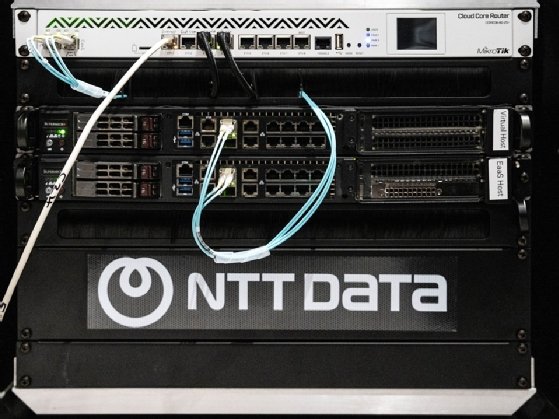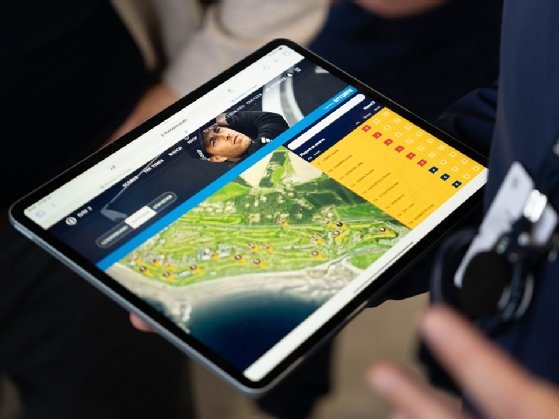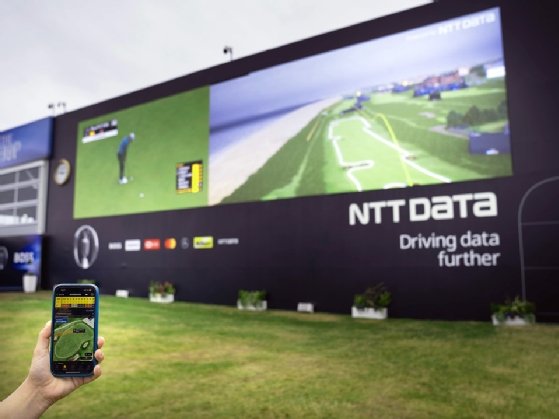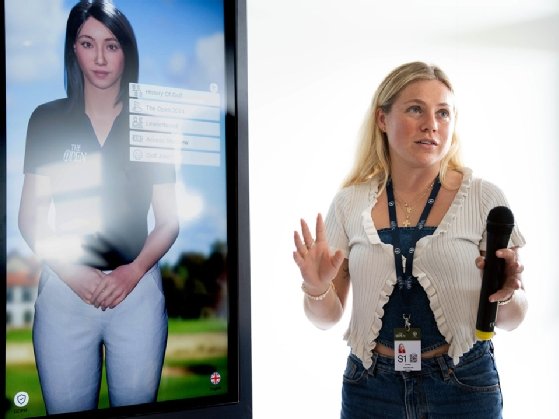Since it was founded in 1754, The Royal and Ancient Golf Club (The R&A) has been a bastion of sporting tradition and history, preserving the rules and spirit of the game – as well as organising the annual Open championship. But it’s also a provider of underground fibre-optic networking and a pioneer in private 5G mobile connectivity.
None of this would have been apparent to the more than 250,000 people who descended on the Royal Troon course on Scotland’s Ayrshire coast for the 152nd Open Championship from 18-21 July – despite many of them taking advantage of the networking capability, as well as a raft of other digital innovations from The R&A and its technology partner NTT Data, intended to enhance the fan experience.
“We want people to use it, but not to see it,” says Steve Otto, chief technology officer (CTO) at The R&A, as Computer Weekly accompanies him around Royal Troon on a behind-the-scenes tour of the tech underpinning this year’s Open golf.
Unlike fixed sporting events, such as Wimbledon or the British Grand Prix, every year the Open is held at a different location, so it’s impossible for The R&A to have the sort of permanent tech setup that a regular venue offers.
But the organisation is so keen to ensure a quality, consistent tech environment that it has installed fibre-optic cabling and ducting one metre below ground around every one of the nine independent golf courses that currently make up the Open roster.
“It’s a 10-year investment case,” says Otto. “Planning for the individual tournament is always ongoing – it just varies where we put it. Things that are venue-specific, such as fibre, that sort of stuff is years out. Part of us blowing the fibre underneath is making sure we’ve got enough resilience.
“We’ve got nine courses on the rota and we’re looking at those all the time, making sure no one’s run into one of the cabinets that are around, for example. Physical infrastructure comes first, digital infrastructure we start to look at around May [for a July tournament].”
That long-term investment in fibre makes even more sense when you consider that another major golf championships, the 2023 Ryder Cup held at the Marco Simone Golf & Country Club in Rome, suffered from the unwanted attention of rats where fibre cables were unable to run through underground ducting because of the archaeological protections around the site.
Private 5G
Another challenge from having a different venue every year comes in sustainability. Typically, the temporary village setup to cater to those quarter of a million fans and the world’s broadcasters and media requires on-site links into the fibre backbone using standard Cat5 cabling that’s installed for the event and thrown away afterwards.
To address this, NTT Data trialled the use of a private 5G “network in a box” at Troon, focused around the hospitality area. This required the short-term purchase of radio spectrum from telecoms regulator Ofcom – a requirement for any private 5G installation in the UK. But it meant that connectivity within its 2km range was available to any device with a suitable nanoSIM card, offering 400Mbps bandwidth.

The next generation of the networking equipment will offer eSIM capabilities, which means that fans visiting the Open could simply scan a QR code to activate eSim software to connect to the private 5G. That’s important to The R&A because they want to maximise fans’ engagement with the event – and the more they use the digital offerings available, the better.
For example, for the 150th Open in 2022, The R&A and NTT Data launched Shot View, a precise virtual representation of each course, which allows fans to track every shot played by the competing golfers using a digital twin that represents the actual trajectory of every shot, in as close to real-time as can be achieved.
Otto says that Shot View increased fans’ dwell time on The Open app tenfold.

Every one of The Open courses has been mapped using drones and Lidar scanning to capture every bump, bunker and slope to 2cm accuracy. During the championship, computer vision cameras set up at every hole track golf balls across the green, while 60 people around the course use GPS trackers to record the location on the fairway where every ball comes to rest.
All of that data is fed into a virtual reality (VR) environment running on Unreal Engine, one of the most popular gaming engines, to plot every movement of the ball. As players tee up at each hole, fans can use Shot View to see exactly how they played the hole on previous days, as well as keep up with what’s happening around the whole course.
Data visualisation
Shot View also feeds into the NTT Data Wall, a 20-metre-wide screen composed of 400 LED panels that sits at the heart of the spectator village. The screen displays live coverage of the event alongside data visualisations from the VR environment.
Computer vision cameras mounted on top of the wall monitor spectator activity to help improve crowd management. Tom Winstanley, CTO at NTT Data, says the cameras also show how many people simply sit in front of the screen and watch the action from there, not unlike the famous Henman Hill at Wimbledon.

All that data collection holds even greater interest for Otto. He’s been involved with The R&A since 1998 when, as a lecturer in mathematics at Birmingham University, he ran a project to model what happens to a golf ball when it’s hit by a club. Six years later, he joined The R&A full time.
With a background in aerodynamics, and nearly three years as a scientist at Nasa, the role of data in improving not just The Open but also the whole game of golf is a driving force.
“When I came in, there was a very small team on equipment standards – how you make rulings on clubs and balls. The R&A realised it needed to invest in that and built a state-of-the-art technology centre to test clubs and balls, so we could part be part of the discussions on equipment,” he says.
The R&A is responsible for governing the rules of golf, including regulations around equipment. The organisation has data going back 100 years – although the further back you go, the more minimal the data, often being just scores. In the mid-1990s, it started recording full data from two holes on every Open course, and has gradually moved on to the course-wide collection in use today.
Deep learning
Otto says The R&A can now simulate past tournaments and use deep learning algorithms to model what impact changes to the rules or equipment specifications would have.
For example, from 2028, The R&A is introducing a new specification for golf balls – initially just for professionals, but from 2030 it will apply to every golfer on the planet, regardless of ability. The change has come about as modern golfers and clubs can hit the ball greater distances than ever before, so the new balls are designed to reduce the distance they will travel, ensuring the sustainability of courses and maintaining competitiveness.
“That was a database decision,” says Otto. “We’re still looking at what might happen with the club in the future – engaging with people where you don’t just sit there and say, ‘Here’s our opinion’ but, ‘Let’s look at the data’.
“So, when I talk about simulating what would happen if we [make a change], based on our own data and other data around the world, let’s say we reduce the golf ball by 5%, what do we think will happen to the scores?”
The data is also used to assess the potential impact of design changes to a course – what would happen if a bunker was moved, for example? It additionally feeds into the placement of the hole on each green during The Open – the position of the hole is different every day.
Data governance
Otto stresses the importance of data governance – “the dullest bit”, he says. For The R&A, this means understanding what to retain and why to retain it, and getting data definitions right to improve the insights that can be delivered going forward.
“Whether it’s AI-driven or whether it’s just human-driven, that’s what the next year will hold for us,” he says. “We have interactions with handicaps for a lot of golfers around the world. The main database holds close to half a billion rounds of golf, and that’s quite an eye-watering number.
“We have interactions with handicaps for a lot of golfers around the world. The main database holds close to half a billion rounds of golf, and that’s quite an eye-watering number”
Steve Otto, The R&A
“So, we no longer have to guess how players play – we know their scoring profiles. Rather than decisions made on small numbers, we can hopefully make them based on big numbers now.”
Looking further ahead, Otto can envisage innovations such as examining whether fitness tracker data from amateur golfers can have value, to better understand how people are playing the game. In South Korea, golf simulators have become incredibly popular, he says – and speculates about what use that data could bring.
For amateur golfers, imagine how much they could improve their game with access to insights from that data in the way that professionals receive a copy of their performance data from The Open and other tournaments.
“Could you play an Open venue against [a professional]? You’ve got the data and you tee off into some sort of virtual space and you’re lined up next to Shane Lowry. How did his approach shot go compared to yours?” says Otto, again imagining what might be possible one day.
Generative AI
All that data also has a clear potential use to train a large language model (LLM) for generative AI (GenAI). This year, NTT Data trialled a digital avatar called Lottie in the controlled environment of the hospitality tent, where visitors can ask conversational questions and Lottie will reply based on an underlying GenAI system.
NTT Data’s Winstanley explains that this year’s version of Lottie uses a recent development called agentic AI, whereby the answers given to users are sourced from multiple LLMs and combined into the information it shares.
In a demonstration of Lottie to Computer Weekly, like a lot of GenAI tools the answers could be of variable quality, and the speed of response a little slow, because the kiosk-style screen is accessing a cloud-based system.

NTT Data has recently announced a range of edge AI products, which in future could speed up the response by keeping AI inference local – and, when combined with a private 5G network, that could open up Lottie’s capabilities to be used by fans around the course via The Open app.
The R&A will continue to uphold the traditions of golf, but The Open shows how data and technology is keeping the game relevant and engaging for its many fans.
For Otto – a golf fan himself – his is a “fantastic” job: “I’m a scientist by background. I’ve worked on very high-tech and highfalutin projects, but a lot of that stuff was about very small elements. One of the best things about what I do is that I get to see the whole picture. I work with some very clever people who know lots more than I do, and we make magic happen. It’s great.”


